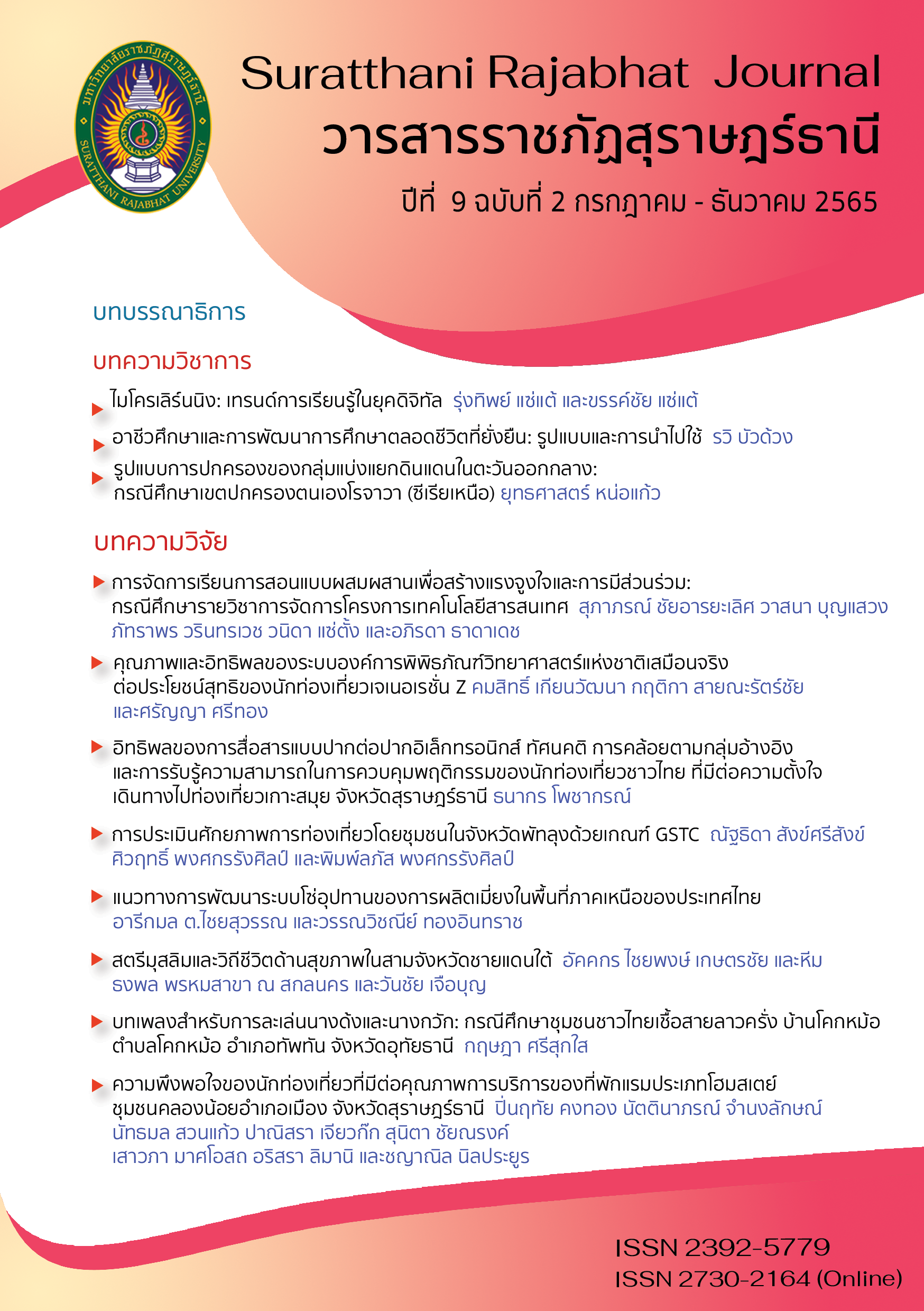The Guidelines for the Development of Supply Chain Analysis of Miang in the Northern of Thailand
Main Article Content
Abstract
The objectives of the study are to analyse the supply chain management of Miang and to find out the guideline for developing the supply chain system of Miang in the Northern of Thailand. The study areas are Barn Mearua Pardang Sub-district Muang District Phrae Province, Barn Par Miang Jachorn Sub-district Muang Parn District Lampang Province and Ban Rhaw Kai Sub-district Meatang District Chiangmai Province. The semi-structure interview was used for collecting data. The process of data analysis was interpreted in a qualitative form. There were 9 informants chosen form 3 research areas. The SWOT analysis was used to evaluate on supply chain management and focus group is used to determine the guideline of Miang supply chain system. The results were founded that the study of Miang supply chain in those 3 areas was green supply chain and it was not complicated. The stakeholder within supply chain composed of the farmer, the distributor and the customer and their function that can be overlaid to each other. The extended supply chain might be used for development of Miang supply chain to manage the risk of cultural impact. Moreover, the concept of investor for joint venture should be applied to the project for maintain the balance of sustainable development. The guideline to develop the supply chain system in the upstream, farmers should be encouraged to have knowledge of preserving Miang because the cultivation of Miang depends on the season. In the midstream, the famers’ knowledge of fermentation process should be provided for decreasing cost. In the downstream, a purchase center should be set up by community leaders in form of the community enterprise and promote the Inno-life based tourism also the forest reservation should be focused.
Article Details

This work is licensed under a Creative Commons Attribution-NonCommercial-NoDerivatives 4.0 International License.
References
โกมล วงศ์อนันต์, และ อภิชา ประกอบเส้ง. (2559). SWOT Analysis ด้าน Planning. http://promrucsa-dba04.blogspot.com/2012/10/swot-analysis-swot-swot-humphrey-swot-2.html.
กัลปพฤกษ์ ผิวทองงาม, ศุภชัย ปทุมนากุล, และคณะ. (2552). เกษตรพันธสัญญา ผลตอบแทน ความเสี่ยง และความเป็นธรรม. (รายงานการวิจัย). กรุงเทพฯ: ซีเวิลด์ กราฟิก.
ไชยยศ ไชยมั่นคง, และ มยุขพันธ์ ไชยมั่นคง. (2560). การจัดการซัพพลายเชนและช่องทางการตลาด. นนทบุรี: บริษัท วิชั่น พรีเพรส จำกัด
บุษกร เชี่ยวจินดากานต์. (2561). เทคนิคการวิจัยคุณภาพแบบกรณีศึกษา. วารสารศิลปศาสตร์ปริทัศน์, 13(25), 103-118.
ประไพพิมพ์ สุธีวสินนนท์, และ ประสพชัย ผสุนนท์. (2559). กลยุทธ์การเลือกตัวอย่างสำหรับการวิจัยเชิงคุณภาพ. วารสารปาริชาต มหาวิทยาลัยทักษิณ, 29(2), 31-48.
เพชรายุทธ์ แซ่หลี, และคณะ. (2562). การศึกษาเพื่อเพิ่มประสิทธิภาพของโซ่อุปทานแตงโมตลาดไทยเจริญ จังหวัดพิษณุโลก. วารสารวิชาการเทคโนโลยีอุตสาหกรรมและวิศวกรรม มหาวิทยาลัยราชภัฏพิบูลสงคราม, 1(2), 64-76.
สถาบันชาและกาแฟแห่งมหาวิทยาลัยแม่ฟ้าหลวง. (2562, ม.ป.ป.). เมี่ยง. https://teacoffee.mfu.ac.th/tc-tea-coffeeknowledge/tc-tea.html
สำนักงานพัฒนาการวิจัยการเกษตร. (2560). การบูรณาการงานวิจัยเมี่ยงเพื่อสืบสานภูมิปัญญาท้องถิ่นและเพิ่มมูลค่าทางเศรษฐกิจ. รายงานฉบับสมบูรณ์.
สำนักพัฒนาและถ่ายทอดเทคโนโลยีการสหกรณ์ กรมส่งเสริมสหกรณ์. (2557). การจัดการห่วงโซ่อุปทาน Supply Chain การเพิ่มมูลค่าห่วงโซ่ผลผลิตหลักของสหกรณ์. นครนายก: ศูนย์ถ่ายทอดเทคโนโลยีการสหกรณ์ที่ 4.
สุจินดา ศรีวัฒนะ. (2560). การบูรณาการงานวิจัยเมี่ยงเพื่อสืบสานภูมิปัญญาท้องถิ่นและเพิ่มมูลค่าทางเศรษฐกิจ. กรุงเทพมหานคร: สำนักงานพัฒนาการวิจัยการเกษตร (องค์การมหาชน).
สุดารัตน์ พิมลรัตนกานต์. (2560). การจัดการห่วงโซ่อุปทานของสินค้าเกษตรกล้วยไม้ในอำเภอพุทธมณฑล จังหวัดนครปฐม. Veridian E-Journal, Silpakorn University ฉบับภาษาไทย สาขามนุษยศาสตร์ สังคมศาสตร์ และศิลปะ, 10(2), 1595-1610.
อันสุดารี กันทะสอน, และ ศุภฤกษ์ ธาราพิทักษ์วงศ์. (2563). การศึกษากระบวนการวางระบบการผลิตชาเมี่ยงโดยประยุกต์ใช้แนวการผลิตแบบลีนของกลุ่มเกษตรกร ตำบลป่าแป๋ อำเภอแม่แตง จังหวัดเชียงใหม่. พิฆเนตวร์สาร, 16(12), 127-138.
Bien.N.C, Phuong.N.T.M & Cuc.N.T.T. (2018). Developing Tea Market through Analyzing the Value Chain of Vietnam Tea Industry. PSAKU International Journal of Interdisciplinary Research, 7(2), 189-195.
Routroy.S & Behera.A. (2017). Agriculture supply chain A systematic review of literature and implications for future research. Journal of Agribusiness in Developing and Emerging Economies, 7(3), 275-302.
Paul. T; & Mondal.S. (2021). Classification of Indian tea supply chain - in context of Assam. International Journal of Process Management and Benchmarking 2021, 11(2), 220 – 253.


